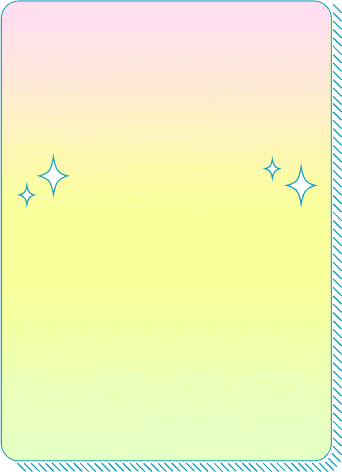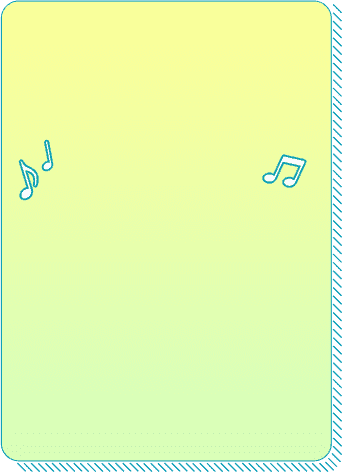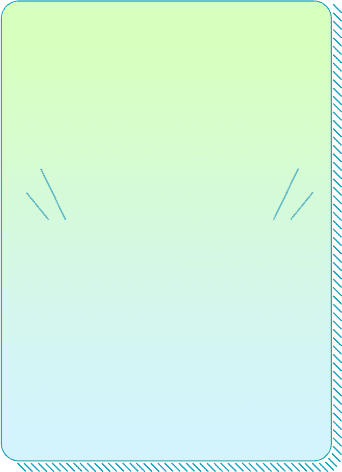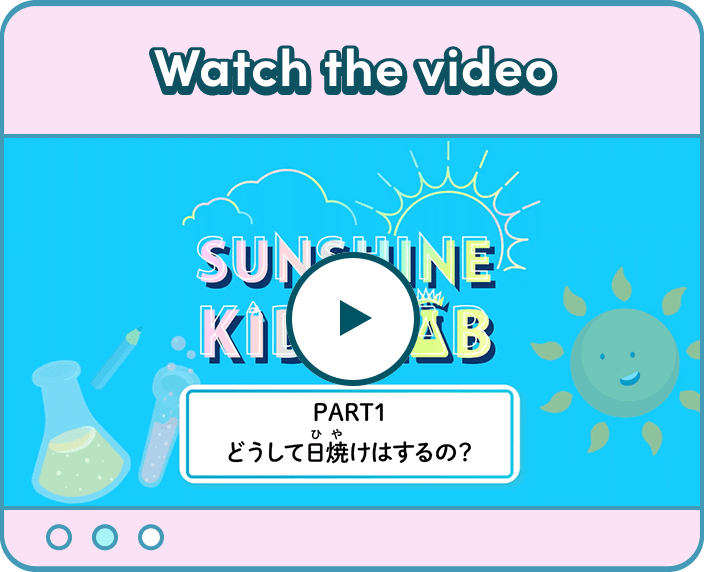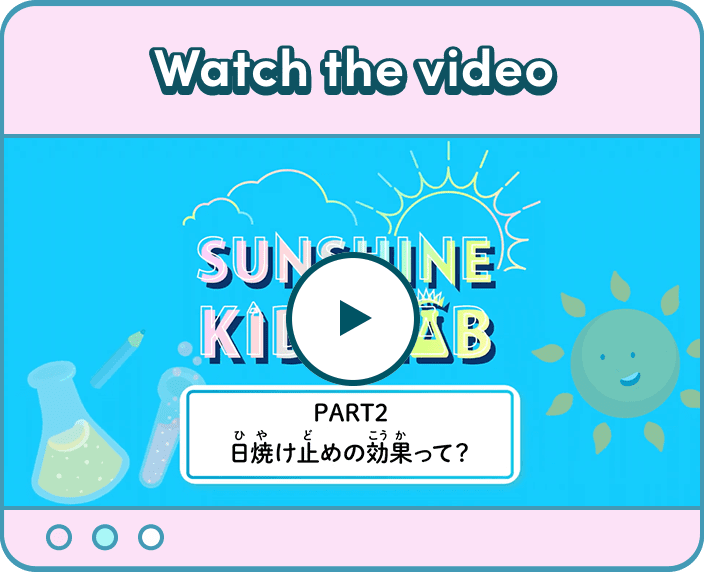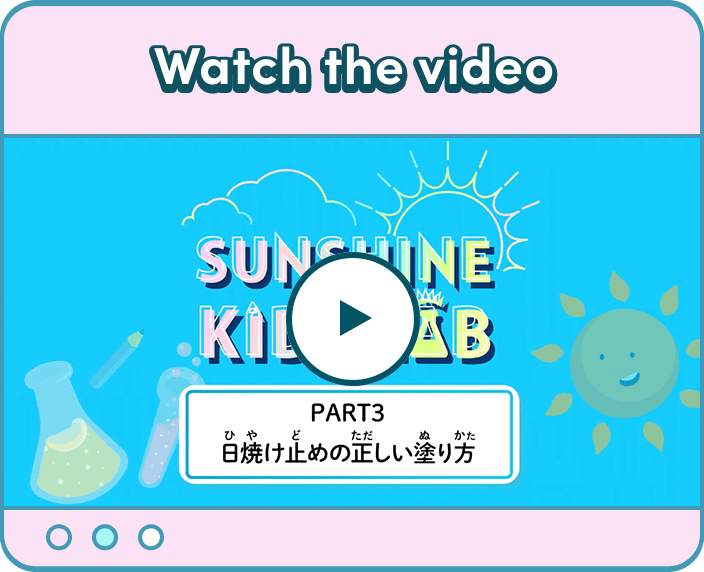
Welcome to the Sunlight Kids Lab!
Welcome to the Sunlight Kids Lab, where we study the sun and our bodies.
Did you know that the earth we live on is a planet that co-exists with the sun?
Without the sunlights, there would be no bright sky and no plants would grow.
From 149.6 million km away, the sunlights affect our skin and body as we live!
Join our lab and let’s study about sunlights and our bodies together!

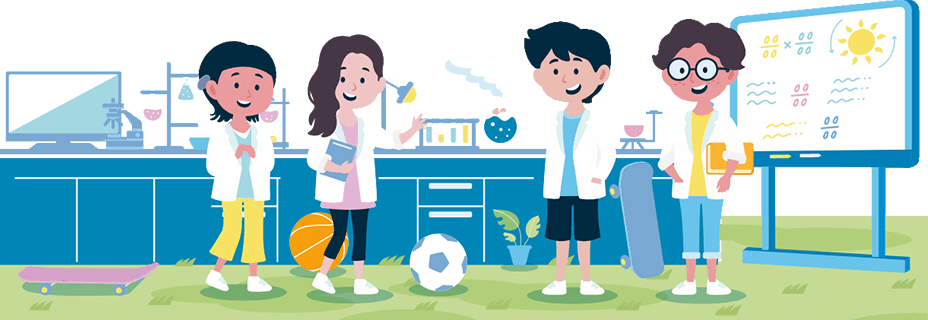
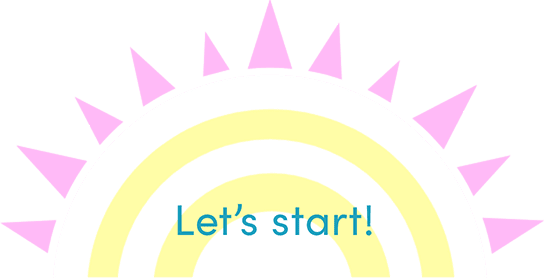

LAB REPORT
Secret behind the Sunlights
What kind of effects does sunlight have?

Sunlight is essential for life and serves many functions.
The Earth is at a good distance from the sun, making it a warm place where life is nurtured.For example.
-
Vitamin D is produced, which aids in the absorption of calcium, necessary for immunity and bone strength
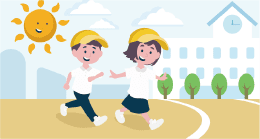
-
Plants photosynthesize, which provides energy for all living things.
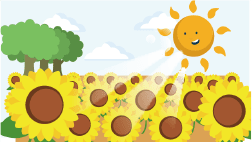
-
They are antibacterial and help to clean our clothes and bedsheets.
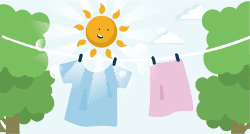
-
When we wake up in the morning and are exposed to the sun, our body rhythms are regulated, and we become healthier.
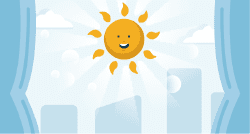
—etc.

Wow! The sun is a very sweet one, isn’t it?

However! If the skin is exposed to too much sunlight, it can cause redness, burning, and changes in color. It can also cause spots and skin cancer!
The ultraviolet rays(UV rays) that are contained in the sun’s rays are said to be the cause!
The mechanism of sunburn
Why do I get sunburn and spots?
The sunburn is caused by the UV rays in the sunlight.
UV rays are invisible to the eye.
They can be divided into three types accordingly to their wavelength: UV-A,UV-B and UV-C.
When the UV-A and UV-B reach the skin and stimulate it, they send signals to the cells called melanocytes, which then produce more pigment called Melanin. This is how we get our skin color changes.
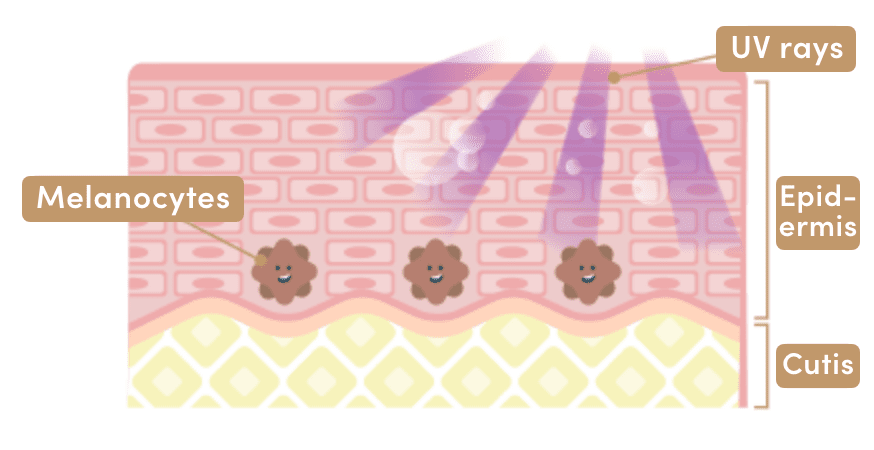
When exposed to UV rays…
Melanocytes produce melanin!
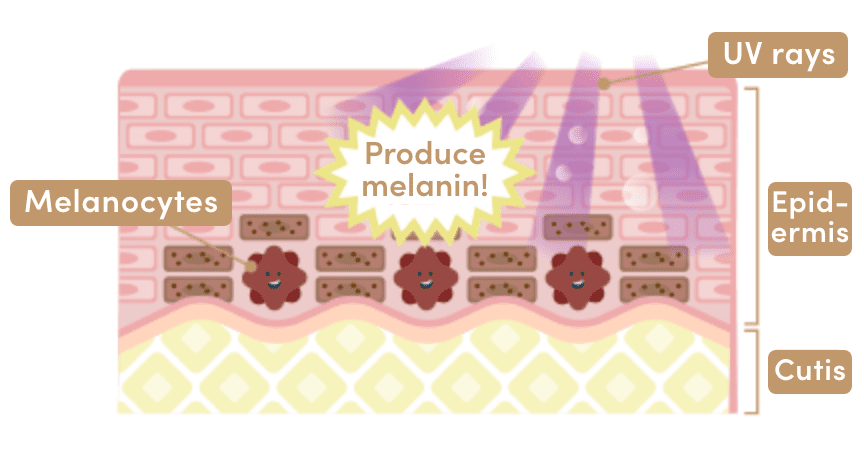
It accounts for about 90% of the UV rays that fall on the earth. It is also called “Everyday UV rays” because it has a long wavelength and reaches the skin through clouds, inside houses and car windows.

But be careful, if too much melanin accumulates, it can lead to spots.
What is UV-A rays?
It accounts for about 90% of the UV rays that fall on the earth. It is also called “Everyday UV rays” because it has a long wavelength and reaches the skin through clouds, inside houses and car windows.
★What happens when you are exposed?
The skin slowly changes color, causing wrinkles and sagging.
What is UV-B rays?
It is also known as “Leisure UV rays” because it is short in wavelength and is the main cause of outdoor sunburn!
★ What happens when you are exposed?
It will immediately cause inflammation and melanin production, which can lead to spots and pigmentation.
Protection from UV rays
Protecting the body from UV rays

Let’s get to know the characteristics of UV rays and take the proper protections!
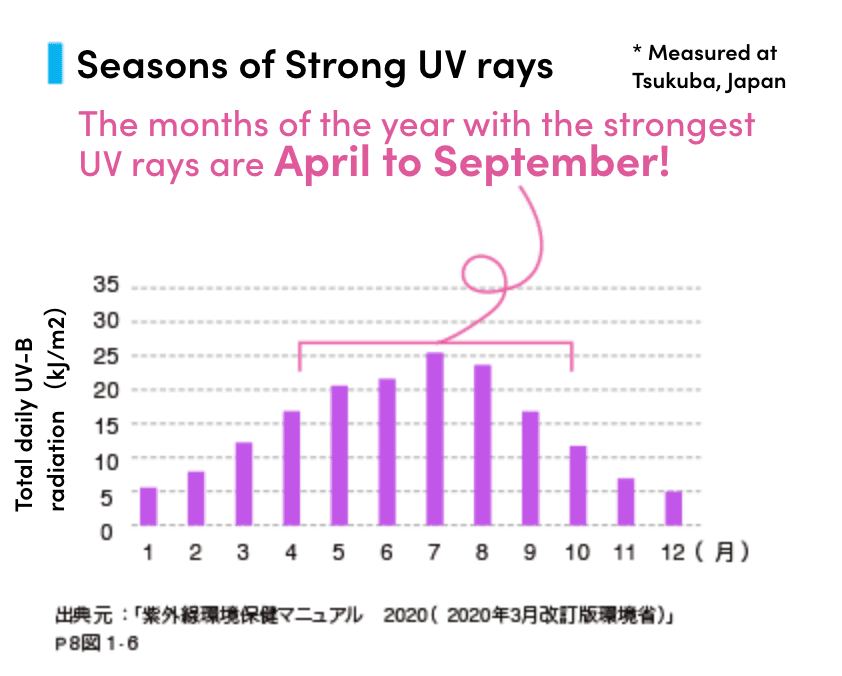

Especially in early spring, when the intensity of the UV rays spikes, so be careful!
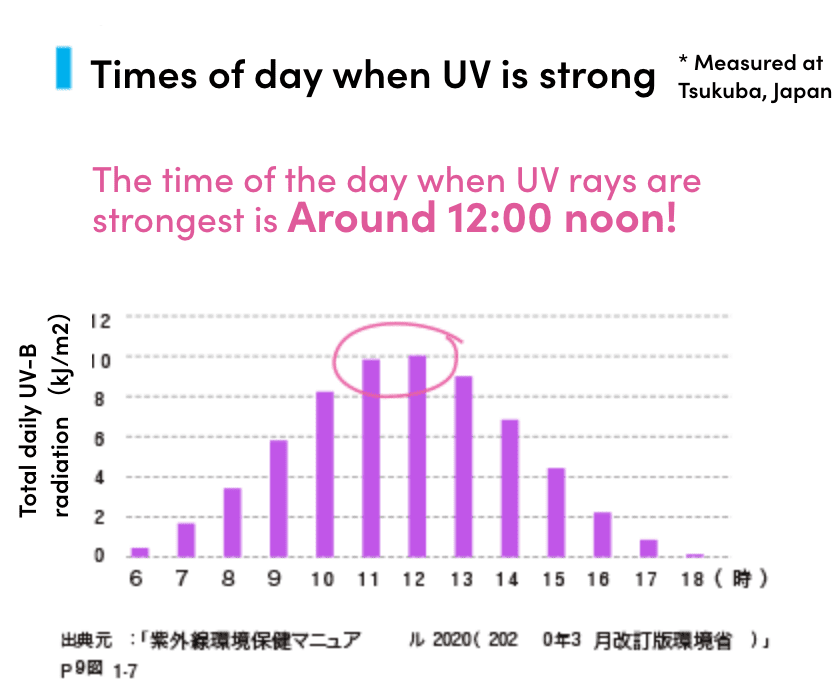

Even on a cloudy day, the UV rays are about 60% of what they are on a sunny day!

Wow! I’ll have to make UV protection a daily habit!
What should I do?
When the UV rays are strong during the day, it is very important to stay in the shade!
In addition, there are other measures you can take.
Arms and legs: long sleeved shirts and pants!
Head and eyes: Hat, sunglasses!
Face, arms and leg: Sunscreen
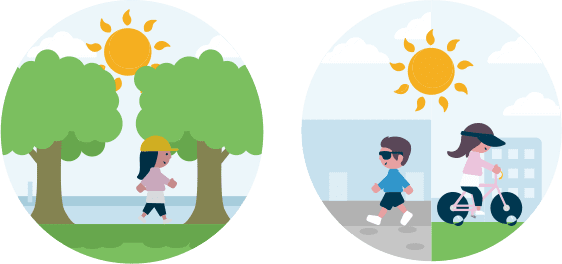

In addition to being careful about what to wear, I could also take a sunscreen!

That’s right!
So this time, I tried this experiment by using a sunscreen!

What does ultraviolet mean?

The sun’s light is actually a mixture of different types of light.
We usually only think of it as “light” because it’s all mixed together. But sometimes the light is broken down and visible. But it can also be seen as a separate type of light.
That’s a rainbow!
You can see the rainbow in different colors depending on the nature of the light, such as red, yellow, and blue.
n addition to the light we can see with our eyes, there are other types of light that we can’t see. If we break down the sun’s rays as they reach the earth…
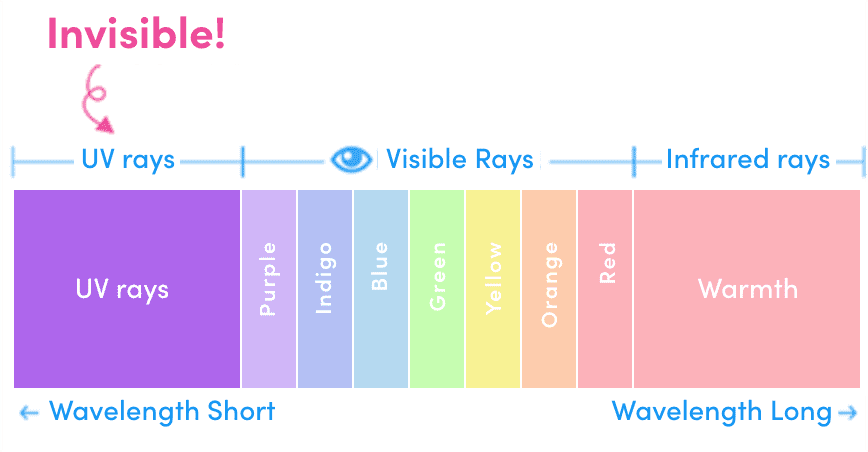
In English, the words “Ultra”, “violet” and “rays” are combined to form the word “UV”.
In English, the words “super”, “violet” and “ray” are combined to form “ULTRA VIOLET RAY” or UV for short.
in the daytime than in the evening or morning

Sunburn is caused by the UV rays contained in the sunlight. Therefore, the more UV rays there are in the sun, the more likely you are to get sunburned.

That’s right! Then why are there more UV rays in the daytime?

The key is a relationship between the position of the sun and the layers of air…
Let’s take a look!!
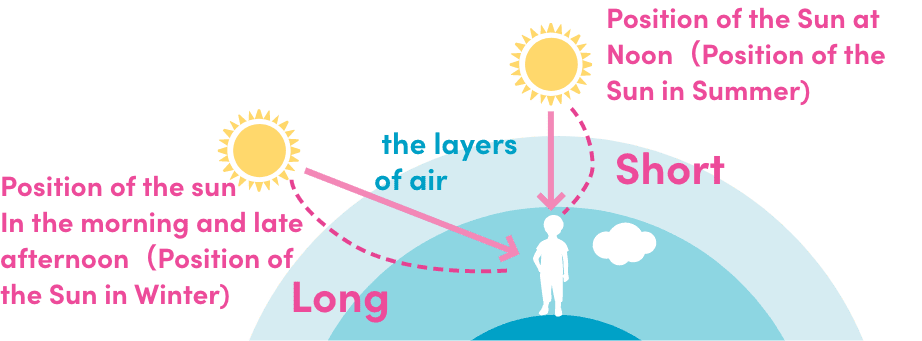
If you look at the position of the sun in the morning and evening, you will see that it is low in the sky.
This means that the UV rays are less intense and you are less likely to get sunburned.
On the other hand, at noon when the sun is higher, the filter is thinner, so it is easier to get sunburned.

In Australia, where the skin cancer rate is particularly high, the government encourages UV protection.
In Australia, there is a famous slogan that means something like this.
・Let’s wear long sleeved shirts!
・Wear sunscreen!
・Wear a hat with a wide brim!
In Australia, there is a famous slogan that means something like this.
In the U.S.A., Canada, and France, education on UV protection is also provided

Even the children use sunglasses to protect their eyes! I didn’t know that sunglasses are not only for fashion
Do you think you only get sunburn in summer?
Don’t you think you don’t get sunburn in winter?
But when you see skiers on TV, you see their goggles all over the place.Why is this?
It’s because of the reflection of the snow. UV rays don’t just shine down from above, they also reflect off the walls and ground.
Particularly on a flat, white surface like a ski slope, a lot of UV rays are reflected. So even in winter, when there is not much rain from above So even in winter when there’s not much coming down from above, you’re still exposed to a lot of UV rays!
If you check the reflection rate in various places….


It’s like a toaster that burns from both sides!
●Hats, sun shades, sunglasses
The brim of the hat should be large enough to protect both the face and the back of the neck! Don’t forget to wear it when you go outside!
●Clothes
Dark, thick materials are recommended. The darker the material, the less UV rays will penetrate. and block them more effectively. If possible, long sleeves are also recommended.

● From the inside of your body too!
In fact, food is also very important!
・Vitamin C, which prevents the production of melanin due to UV rays and lightens the melanin already produced.
・ Vitamin A and beta-carotene, which are important for the metabolism and antioxidant function against UV damage to the skin. .
These nutrients in the food can help you avoid getting too much of a sunburn.
How to properly apply sunscreen
What is the right way to apply sunscreen?
For those who tend to forget to wear sunscreen, apply it to the face, the neck, and all over the body every morning, maybe after washing the case or taking care of the skin.
-
3 steps to apply to the face and the neck
(1) Place a optimal amount of sunscreen on the palm of your hand, and apply to five areas of your face (Left and right cheeks, forehead, nose and chin).
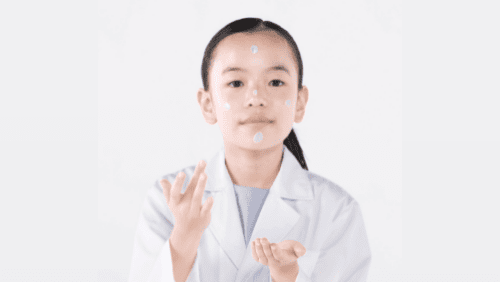
-
(2) Apply carefully to all parts of the face. After applying, take another amount and apply again.
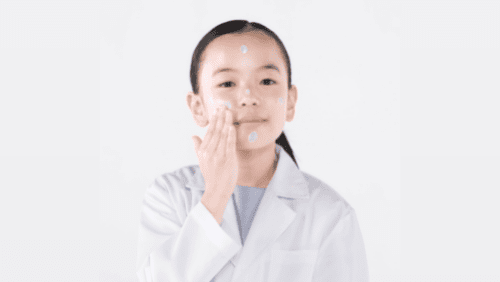
-
(3)Apply to the neck!
Again, take a optimal amount of sunscreen on the palm of the hand and apply to several places, spreading it lightly and blending it in. Finally, spread from the bottom to the top.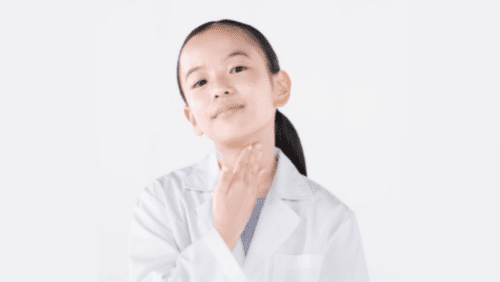
-
How to apply to your body: 2 steps
(1) Apply directly from the bottle in a line on the skin.
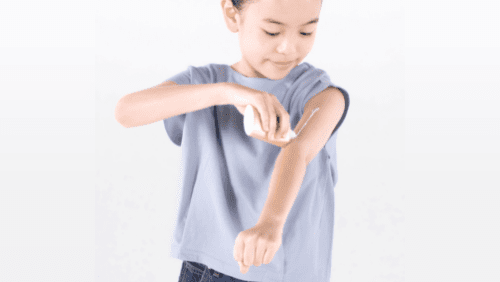
-
(2) Apply to the skin with the palm of your hand. Gently spread and blend in a large circular motion.
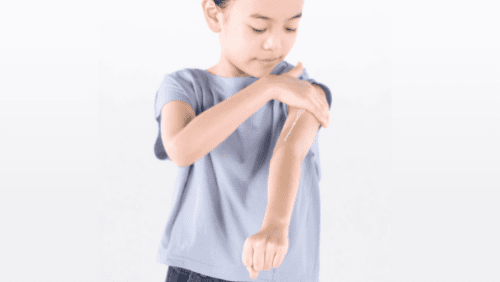
Be careful not to apply too much at one time or too little at a time, as it can easily become uneven.

The following 7 areas are especially easy to leave unapplied! Don’t forget to check them!
- ・Hairline
- ・Back of the chin
- ・Eyelids
- ・Back of the ear
- ・The wings of the nose
- ・Around the mouth
- ・Back of the neck

●Don’t forget to reapply!
It is important to reapply to the part of the body that are sensitive to UV rays or easily get sunburned.
It’s the best to reapply after swimming for a long time, sweating, or using a sweat wipe. It is recommended to reapply every two to three hours to maintain the effect.

MORE RESEARCH
SPF, which is written on the sunscreen, means that it is effective in preventing ultraviolet rays (UV-B).
SPF is an abbreviation for
Sun
Protection
Factor.
The larger the number, the greater the effect, and for PA, ++++ (Four Plus) is the highest level!
It is important to select the SPF number that matches the location and occasion, checking its exposure to UV rays.


1. If it hurts…
Use water to cool skin vigorously.
Do not use soap or cosmetics.
(Sunburn is a form of of skin burn and should be treated by a physician.)
2. If the pain has eased…
but the skin is still hot... apply an after-sun care product.
3. When the pain and redness subsides…
Use a moisturizer or emulsion to replenish water and oil to keep your skin moisturized.
UV rays can weaken the body’s immune system, making you feel tired, so it’s important to eat and rest.
Take vitamin C to prevent skin aging and vitamin A to help skin regenerate. Make sure you get plenty of sleep.
There are two types of UV rays: UV-B rays and UV-A rays, and it is necessary to protect your skin from both.
SPF and PA are the standards for protecting your skin from UV-B rays, while PA protects against UV-A rays.
SPF and PA are written on the package of the product, so make sure to check them before you choose! Please choose the product that best matches where you are going.

Baby’s skin is more delicate than a human’s!
There are some points to consider when choosing and using a sunscreen!
●What kind of sun protection should I choose for babies?
Let’s use a mild type of sunscreen that can be used on the skin of babies!

There are three key points!
①Addictive-free, fragrance-free, no artificial coloring added
②Easy to apply, easy to remove with soap
③SPF and PA in a certain level.
●When can babies start to use sunscreen?
It depends on the product, so it is very important to read the instructions on the package carefully!
Especially for babies under 1 year old, their skin is still not mature, so it is best to avoid going out during periods of strong sunshine.

It’s not enough to just rely on sunscreen, but it’s also important to physically protect your skin with sunshades, hats, and light jackets.
●What should I be careful about when applying sunscreen to babies?
The back of the neck and hand, insteps, the area around the elbows and knees are all areas that are prone to sunburn, so it’s important to be aware of these areas.

It’s also important to avoid the delicate areas around the eyes and mouth.
●How to remove sunscreen without damaging the skin?
Use facial wash for face, soap or body wash for body, wash off gently wash with no pressure. If you are having trouble removing the sunscreen, wet your skin and apply the soap or body wash directly to the skin, then make bubble and wash with a body towel or sponge.

Let’s remember to use proper sun protection and enjoy going out with your little brother or sister to the fullest!

Let’s make UV Bracelet with UV beads that change color under UV rays to observe it!

Is it possible to make accessories that change color under UV light? I want to do it too!
But it looks so difficult…

It’s actually very easy! Let’s all make a pair and do research together!
Things to be prepared
・Round beads (approx. 6mm): 18 pcs.
・UV beads(approx. 8 mm): 4pcs
・Beads of your choice(approx. 10 mm): 4pcs
・Elastic string(approx. 23 mm)
・Tape
・Scissors
※When using scissors, please make sure to work with an adult.
How to make a UV Bracelet
(1) Use tape to hold one side of the elastic string in place.
(2) Next, thread seven 6mm round beads, and then one 10mm bead.
(3) Thread one more 6mm round bead, and then two UV beads.
(4) The next step is to add one 6mm round bead, one 10mm bead, and then another 6mm round bead.
(5) After threading two UV beads, reverse the order and thread one 6 mm bead, one 10 mm bead, and seven 6 mm beads.
(6) Finally, thread one 10mm bead through…
(7)Tie the ends of the elastic string together to form a loop and tie it tightly about five times. If you are concerned about the strength of the knot, stick some bond to it.
(8) Insert the leftover ends of the string into the two or three beads on the side.
This may be a little difficult to do at first if you are not used to it, but if you just pull the string a little bit, it will go in easily!
(9) Cut off the ends of the string that are sticking out and you’re done!

It was so easy to make!

This will make observing the UV rays a lot of fun! I wonder how the color changes with time and place.




Let’s all go outside and try it out!
Be sure to protect yourself from the UV rays by wearing a hat
and sunscreen when you go outside!

REPORT SUMMARY
and enjoy going
outside!


